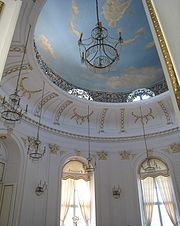
Jabłonna Palace
Encyclopedia
Jabłonna Palace is a palace, hotel and publicly accessible park-complex in Jabłonna, Poland
whose uses include conferences and weddings.
Jabłonna was the property of the Bishops of Płock, who built a summer residence here in the 15th century. In 1773 the brother of the King Stanisław August - Michał Poniatowski, then Bishop of Płock and later the primate of Poland, bought the property in Jabłonna with the intention of turning it into an elegant palace-and-park residential complex. In 1774 he commissioned the royal architect, Dominik Merlini
, to design the new residence. The construction of a three-building complex was proposed: a one-storey palace, which was intended to be the residence of the owner, was to be situated in the middle and flanked on both sides by separate three-storey pavilions.
 A scenic English-style park was developed in the 1770s and 1780s, based on the design of architect Szymon Bogumił Zug. The same architect also constructed a series of pavilions, of which three still remain today: the Grotto, the Orangerie and the Chinese Pavilion.
A scenic English-style park was developed in the 1770s and 1780s, based on the design of architect Szymon Bogumił Zug. The same architect also constructed a series of pavilions, of which three still remain today: the Grotto, the Orangerie and the Chinese Pavilion.
Originally, the central palace combined the austerity of the classical style with the baroque picturesqueness.
Over the next 40 years the buildings were extensively remodelled and added to coinciding with a number of changes of ownership. In 1837 the palace was rebuilt according to the design of Henryk Marconi
.
Jabłonna was owned by the Potocki family until 1945. In 1944 the palace was burned by the German army. Since 1953 Jabłonna has been owned by the Polish Academy of Sciences
. Under its auspices the palace was transformed into the conference and recreational centre. The reconstruction of the palace was executed according to the design of Mieczysław Kuźma, the reconstruction of the park according to the design of Gerard Ciołek. In the course of this renovation, the central part of the palace was restored to look as it did at the end of the 18th century, while its side parts, added in the first half of the 19th century, retained their original appearance. The furnishing and decoration of the palace interior was completed after 1945. The representative halls and chambers of the palace were decorated with old furniture and paintings from the end of the 18th and the first half of the 19th centuries.
Poland
Poland , officially the Republic of Poland , is a country in Central Europe bordered by Germany to the west; the Czech Republic and Slovakia to the south; Ukraine, Belarus and Lithuania to the east; and the Baltic Sea and Kaliningrad Oblast, a Russian exclave, to the north...
whose uses include conferences and weddings.
History
During the Middle AgesMiddle Ages
The Middle Ages is a periodization of European history from the 5th century to the 15th century. The Middle Ages follows the fall of the Western Roman Empire in 476 and precedes the Early Modern Era. It is the middle period of a three-period division of Western history: Classic, Medieval and Modern...
Jabłonna was the property of the Bishops of Płock, who built a summer residence here in the 15th century. In 1773 the brother of the King Stanisław August - Michał Poniatowski, then Bishop of Płock and later the primate of Poland, bought the property in Jabłonna with the intention of turning it into an elegant palace-and-park residential complex. In 1774 he commissioned the royal architect, Dominik Merlini
Domenico Merlini
Domenico Merlini was an Italian-Polish architect whose work was mostly in the classical style.-Life and Style:...
, to design the new residence. The construction of a three-building complex was proposed: a one-storey palace, which was intended to be the residence of the owner, was to be situated in the middle and flanked on both sides by separate three-storey pavilions.

Originally, the central palace combined the austerity of the classical style with the baroque picturesqueness.
Over the next 40 years the buildings were extensively remodelled and added to coinciding with a number of changes of ownership. In 1837 the palace was rebuilt according to the design of Henryk Marconi
Enrico Marconi
Enrico Marconi, known in Poland as Henryk Marconi , was an Italian architect who spent most of his life in Congress Poland....
.
Jabłonna was owned by the Potocki family until 1945. In 1944 the palace was burned by the German army. Since 1953 Jabłonna has been owned by the Polish Academy of Sciences
Polish Academy of Sciences
The Polish Academy of Sciences, headquartered in Warsaw, is one of two Polish institutions having the nature of an academy of sciences.-History:...
. Under its auspices the palace was transformed into the conference and recreational centre. The reconstruction of the palace was executed according to the design of Mieczysław Kuźma, the reconstruction of the park according to the design of Gerard Ciołek. In the course of this renovation, the central part of the palace was restored to look as it did at the end of the 18th century, while its side parts, added in the first half of the 19th century, retained their original appearance. The furnishing and decoration of the palace interior was completed after 1945. The representative halls and chambers of the palace were decorated with old furniture and paintings from the end of the 18th and the first half of the 19th centuries.

